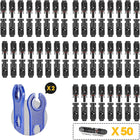What is MPPT Solar Charge Controller?

The energy transformation of industry is underway. Ecological awareness is spreading. Do you want to know more about the means of autonomous energy production? Be aware that they are getting easier and easier to install. Solar panels, battery, MPPT solar charge controller, don't be afraid of using them!
An MPPT (Maximum Power Point Tracking) solar charge controller is a device used in solar power systems to optimize the charging of batteries by maximizing the power output from solar panels. It ensures that the solar panels operate at their most efficient voltage and current levels, which is known as the "maximum power point."
What are the advantages of an MPPT charge controller?
Thinking of equipping your building with autonomous lighting? Your parking entrance from a control terminal? Your delivery dock for an automatic headlight? Do you want to use a solar kit to reduce installation costs? The solar charge controller will be part of the installed kit. This material is often in the form of a small box. It makes an autonomous electrical system more efficient. It sits at the interconnection between solar panels, batteries, and the consuming application.
Here is a list of the advantages of the MPPT solar charge controller:
-
Variable Voltage Input: They can handle a wide range of input voltages, making them compatible with various solar panel configurations.
-
Real-Time Adjustment: The controller constantly adjusts the load on the solar panels to match the maximum power point, even as environmental conditions (like sunlight intensity) change.
-
Battery Protection: MPPT controllers manage the charging process to prevent battery overcharging, extending battery life.
-
System Compatibility: They are often used in larger solar systems or those with higher voltage solar panels, where maximizing energy conversion is critical.
How does the MPPT solar charge controller work?
1. Understanding the Maximum Power Point (MPP):
- Solar panels have a characteristic curve that shows the relationship between voltage (V) and current (I). The point on this curve where the product of voltage and current (V × I) is maximized is called the Maximum Power Point (MPP).
- The MPP varies depending on environmental conditions, such as sunlight intensity, temperature, and shading.
2. Tracking the MPP:
- The MPPT controller continuously tracks the MPP by adjusting the electrical load on the solar panel to find and maintain operation at the point where maximum power is produced.
- This is done using algorithms that monitor the voltage and current and adjust the panel's operating point to ensure it stays at the MPP.
3. Converting Voltage and Current:
- The controller can step up or step down the voltage to match the battery's requirements. For instance, if the solar panel's optimal operating voltage is higher than the battery's voltage, the MPPT controller will step down the voltage while increasing the current to maintain the same power level (Power = Voltage × Current).
- This voltage conversion allows the solar panel to operate at its most efficient point, regardless of the battery's voltage.
4. Delivering Power to the Battery:
- Once the MPPT controller has optimized the power output from the solar panels, it regulates the charging current and voltage to safely charge the battery without overcharging it.
- It adjusts the charging process based on the battery’s state of charge, preventing damage and extending battery life.
5. Dynamic Adjustment:
- The MPPT controller continuously adjusts to changing conditions (e.g., varying sunlight) to ensure that the solar panels are always operating at their maximum efficiency. This dynamic adjustment is what distinguishes MPPT controllers from simpler PWM (Pulse Width Modulation) controllers.
Example:
- Scenario: A solar panel might produce its maximum power at 18V and 5A, giving 90W of power.
- Without MPPT: If directly connected to a 12V battery, the voltage might drop to 12V, and the current might be 5A, resulting in only 60W (12V × 5A) being delivered.
- With MPPT: The controller will adjust the voltage down to 12V but increase the current to around 7.5A (keeping the power close to 90W), thus maximizing the energy extracted from the solar panel.
In essence, an MPPT solar charge controller ensures that the solar panels are always delivering the most power possible, optimizing the energy conversion process and making the overall solar system more efficient. BougeRV offers you products adapted to your needs. The solar panels, MPPT solar charge controller, solar inverters, and the solar connectors that we offer will be your best choice to your solar system.
















































































































































































































